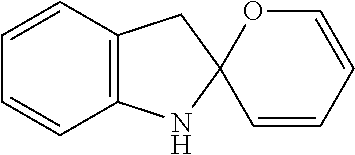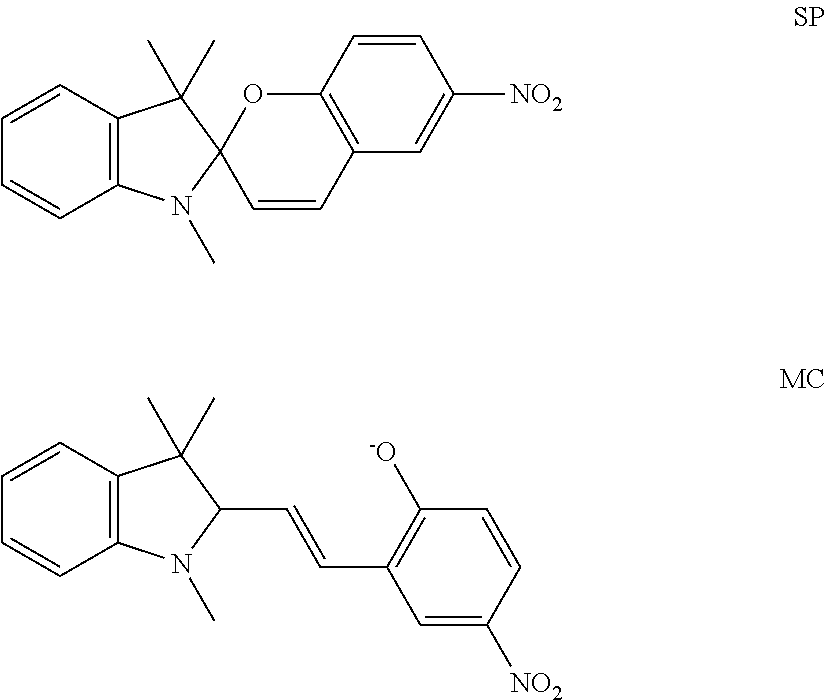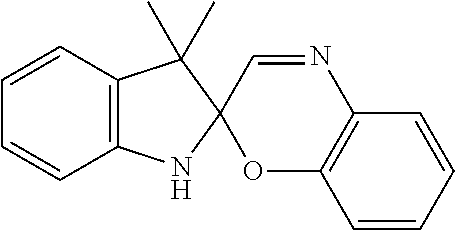[0010]Photochromes that can transform into two independent light absorbers upon
irradiation can be used in the
polymer. For example, photoinduction of certain spirooxazine photochromes can promote the simultaneous formation of two chromophores able to absorb in the visible region. Photochrome “dyads,”“hybrids,” or “multi-photochromes” can also be used in the
polymer. Exemplary multi-photochromes are compounds having two photochrome moieties, such as napthopyran-dithienylethene conjugates.
Irradiation using different wavelengths of light can promote the formation of isomers which have various spectral characteristics.
[0011]A photochrome having a
fluorescence property can be used in the
polymer. Some fluorescent photochromes are absorptive to visible light and fluoresce under illumination. Certain photochromes can also fluoresce following UV illumination. Some fluorescent photochromes can change from fluorescent to non-fluorescent following illumination. Some fluorescent photochromes can be “
hybrid” molecules that combine a fluorescent
moiety and a non-fluorescent photochrome. The photochrome can have an
emission spectrum that overlaps with the absorption spectrum of the
fluorescence moiety when the photochrome
moiety is in the transformed state. The
polymeric matrix can be visualized by presence or absence of
fluorescence of the fluorescence moiety, depending on the state of the photochrome. For example, the photochrome (when in a transformed state) transfers energy to the fluorescence moiety, and promotes
visualization of the
polymeric matrix by fluorescence. Use of such a biocompatible photochrome-containing polymer can provide the
advantage of understanding whether the matrix has been irradiated, as well as
visualization of the matrix.
[0014]
Visualization is useful for various processes associated with use of the medical article, including detection of the polymeric matrix during an
insertion, implantation, or in situ formation process.
Visualization can also be useful to assess the quality of the polymeric matrix. For example, in some aspects the invention provides a method for forming a polymeric matrix, such as a
coating, which includes a step of irradiating the
coating causing crosslinking and / or covalent immobilization of the polymeric material. In some
modes of practice, irradiation of a photochrome-containing polymer during the crosslinking / immobilization process makes the polymeric material optically detectable, thereby allowing the user to confirm that the polymeric material was indeed irradiated. The use of a fluorescence photochrome provides increased sensitivity and allows for use of detection equipment that can quantitatively assess emission (fluorescence) from the irradiated polymer.
[0016]In one aspect, the biocompatible photochrome- or near IR dye-containing polymer includes a polymeric backbone and a pendent photochrome moiety or near IR dye moiety bonded to the polymer backbone in a particular chemical arrangement. In the arrangement, the photochrome moiety or near IR dye moiety includes a ring
heteroatom, which is used to covalently bond the photochrome moiety or near IR dye moiety to the polymer backbone through a spacer group. The synthetic method used to form this photochrome-containing or near IR dye-containing polymer provides a biocompatible polymer preparation, and the preparation can be used to form all or a portion of a medical article, for example, a coating, an implantable
medical device, or an in situ formed hydrogel. The
biocompatibility of the preparation can advantageously carry over into the implantable
medical device.
[0018]In another aspect, the biocompatible photochrome-containing polymer includes a polymeric backbone, a pendent photochrome moiety or near IR dye bonded to the polymer backbone, and a pendent reactive group. The pendent reactive group allows for polymer crosslinking or bonding of the polymer to a target moiety, which can improve properties of the polymeric matrix, such as matrix durability and / or adhesion. In some aspects, the reactive group is a photoreactive group capable of activation and covalent bonding to a target moiety. The photoreactive group can be an
aryl ketone species capable of UV light-induced activation. Other reactive groups which can be pendent from the photochrome-containing polymer include ethylenically unsaturated groups capable of being free-radically polymerized. In this sense, use of ethylenically unsaturated groups provides a photochrome- or near IR dye-containing macromer that can be used to enhance matrix formation.
[0020]Photochrome or near IR dyes having peak absorptions of about 650 nm or greater are preferred for use on polymer also having UV activated pendent reactive groups. Treatment of the polymer with UV irradiation to promote covalent crosslinking or bonding of the polymer to a surface to form the matrix results in minimal or no bleaching of the photochrome or near IR dye. The resulting polymeric matrix that is formed is able to subsequently irradiated at the absorption peak of the photochrome or near IR dye to allow for detection of the polymeric matrix.
 Login to View More
Login to View More 


